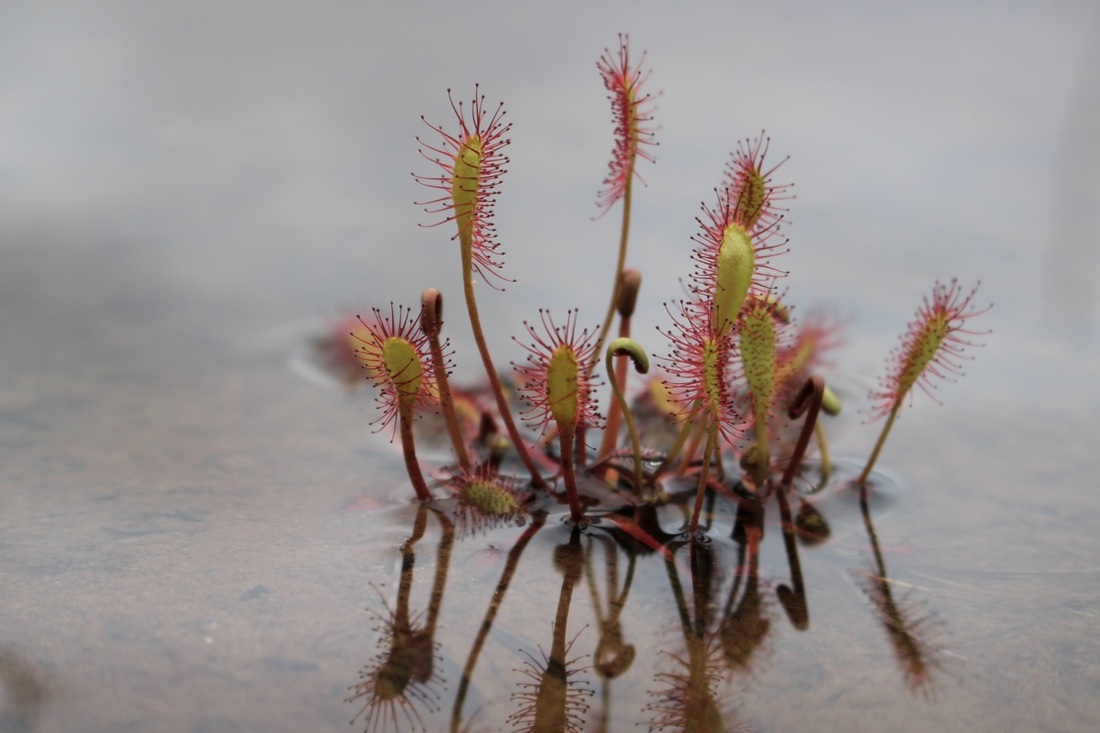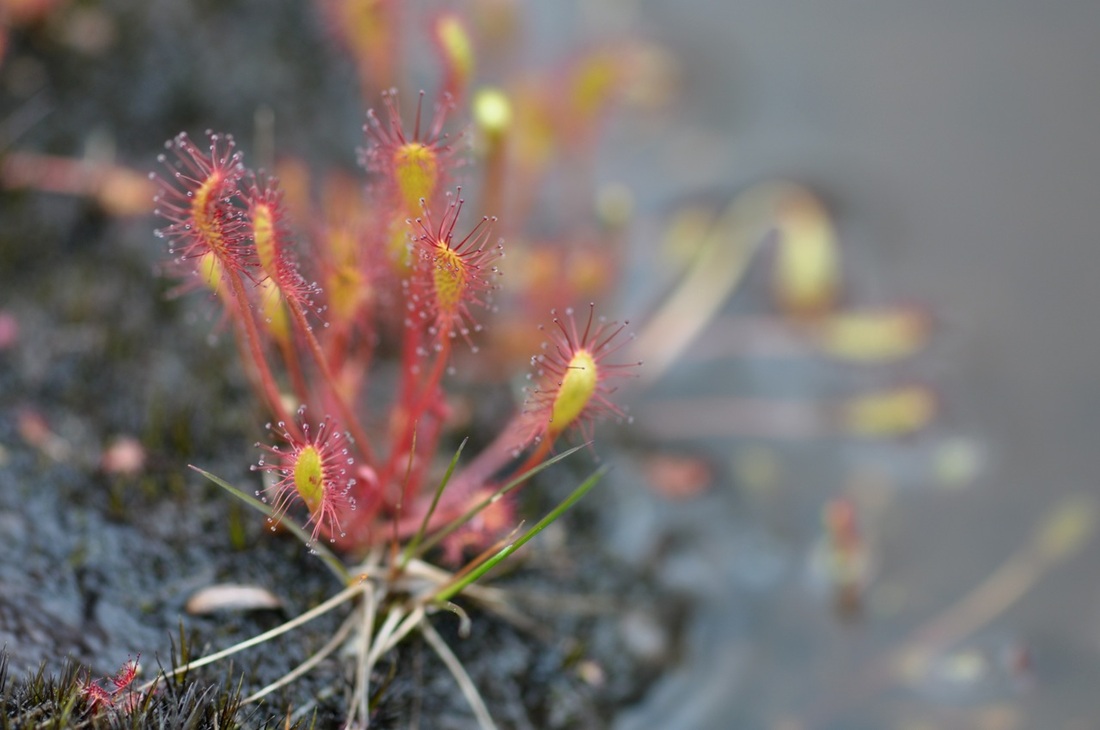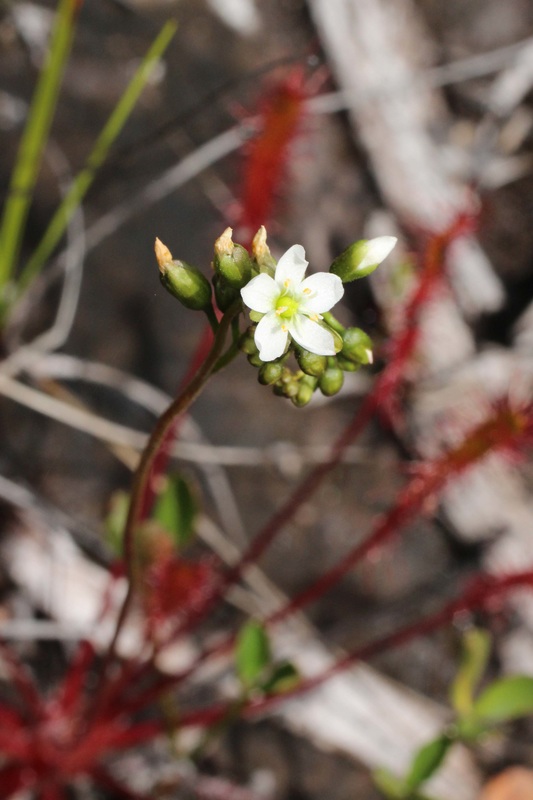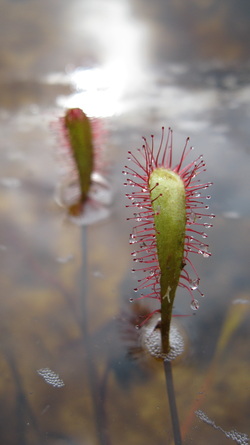Great sundew, English sundew • Drosera anglica
Identification
The great sundew is a small carnivorous plant that grows no more than 25 cm tall. It is easily recognizable from the long red 'tentacles' covered with drops of 'dew' that are actually a sticky liquid the plant produces. The leaves are narrow, at least 2 times as long as they are wide.
Habitat & Range
Sundews are found in wet, nutrient-poor sites like bogs, fens and wet meadows, from low to middle elevations.
They are found throughout coastal and interior BC, and have a broad range that extends across the Northern Hemisphere in much of North America, Europe, and Asia. It is also found in Hawaii.
Similar Species
Great sundew is very similar to round-leaved sundew (Drosera rotundifolia), varying only in leaf shape. Round-leaved sundew has leaves that vary from round to egg-shaped, and is much more common.
Intriguing Info
Great sundew traps insects with its sticky tentacles, breaking them down with enzymes and using them for food. As they are often found in nitrogen-poor sites, these insects offer a supplement of this nutrient for the plant. Other insectivorous plants in coastal BC include the round-leaved sundew and the common butterwort (Pinguicula vulgaris). A video of a round-leaved sundew capturing an ant can be viewed here.
iNaturalist
https://www.inaturalist.org/taxa/52655-Drosera-anglica
The great sundew is a small carnivorous plant that grows no more than 25 cm tall. It is easily recognizable from the long red 'tentacles' covered with drops of 'dew' that are actually a sticky liquid the plant produces. The leaves are narrow, at least 2 times as long as they are wide.
Habitat & Range
Sundews are found in wet, nutrient-poor sites like bogs, fens and wet meadows, from low to middle elevations.
They are found throughout coastal and interior BC, and have a broad range that extends across the Northern Hemisphere in much of North America, Europe, and Asia. It is also found in Hawaii.
Similar Species
Great sundew is very similar to round-leaved sundew (Drosera rotundifolia), varying only in leaf shape. Round-leaved sundew has leaves that vary from round to egg-shaped, and is much more common.
Intriguing Info
Great sundew traps insects with its sticky tentacles, breaking them down with enzymes and using them for food. As they are often found in nitrogen-poor sites, these insects offer a supplement of this nutrient for the plant. Other insectivorous plants in coastal BC include the round-leaved sundew and the common butterwort (Pinguicula vulgaris). A video of a round-leaved sundew capturing an ant can be viewed here.
iNaturalist
https://www.inaturalist.org/taxa/52655-Drosera-anglica
References
Drosera anglica Huds. English sundew; great sundew. In Klinkenberg, Brian. (Ed.). E-Flora BC: Electronic Atlas of the Plants of British Columbia [eflora.bc.ca]. Lab for Advanced Spatial Analysis, Department of Geography, University of British Columbia, Vancouver. Accessed on 01/26/13.
Pojar, J. and MacKinnon, A. (2005). Plants of Coastal British Columbia, Revised. Vancouver, BC: Lone Pine Publishing. P. 351.
Authors and editors of page
Chanda Brietzke and Brian Starzomski (2013).
Drosera anglica Huds. English sundew; great sundew. In Klinkenberg, Brian. (Ed.). E-Flora BC: Electronic Atlas of the Plants of British Columbia [eflora.bc.ca]. Lab for Advanced Spatial Analysis, Department of Geography, University of British Columbia, Vancouver. Accessed on 01/26/13.
Pojar, J. and MacKinnon, A. (2005). Plants of Coastal British Columbia, Revised. Vancouver, BC: Lone Pine Publishing. P. 351.
Authors and editors of page
Chanda Brietzke and Brian Starzomski (2013).








